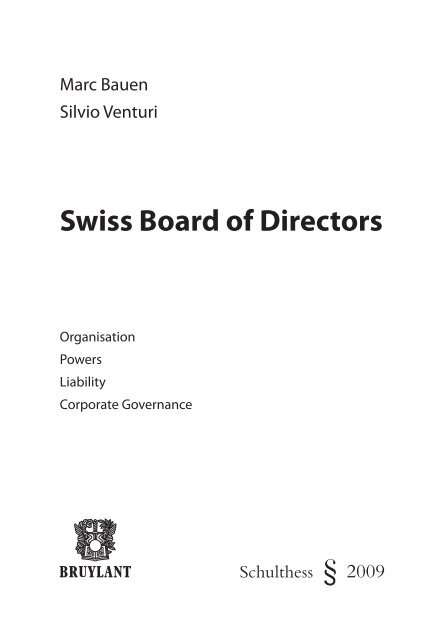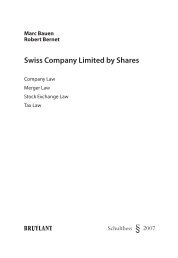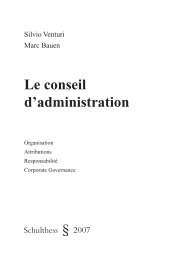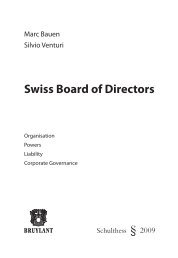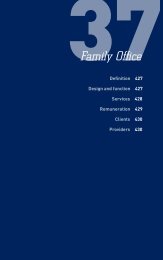Swiss Board of Directors - marc bauen
Swiss Board of Directors - marc bauen
Swiss Board of Directors - marc bauen
You also want an ePaper? Increase the reach of your titles
YUMPU automatically turns print PDFs into web optimized ePapers that Google loves.
Marc Bauen<br />
Silvio Venturi<br />
<strong>Swiss</strong> <strong>Board</strong> <strong>of</strong> <strong>Directors</strong><br />
Organisation<br />
Powers<br />
Liability<br />
Corporate Governance
Bibliographic information published by ‹Die Deutsche Bibliothek›<br />
Die Deutsche Bibliothek lists this publication in the Deutsche Nationalbibliografi e; detailed bibliographic<br />
data are available on the Internet at ‹http://dnb.ddb.de›.<br />
All rights reserved<br />
No part <strong>of</strong> the material protected by this copyright notice may be reproduced or utilized in any<br />
form or by any means, electronic or mechanical, including photocopying, recording, or by any information<br />
storage or retrieval system, without written permission from the copyright owner.<br />
Chromatic cover design: Silvia Buol, Basel<br />
© Schulthess Juristische Medien AG, Zurich · Basel · Geneva 2009<br />
ISBN 978-3-7255-5572-7 Schulthess Juristische Medien AG, Zurich · Basel · Geneva<br />
ISBN 978-2-8027-2644-9 Bruylant, Bruxelles<br />
www.schulthess.com<br />
www.bruylant.be
Table <strong>of</strong> Contents<br />
Foreword V<br />
Summary VII<br />
List <strong>of</strong> Abbreviations XXIII<br />
Bibliography XXXI<br />
Introduction LIII<br />
§ 1 General Provisions 1<br />
1. Introductory Remarks<br />
1.1 The <strong>Board</strong> <strong>of</strong> <strong>Directors</strong> as the Executive <strong>of</strong> a Company Limited<br />
3<br />
by Shares 3<br />
1.2 Monistic or Dualistic System <strong>of</strong> Organisation 3<br />
1.3 Personal Requirements 5<br />
1.3.1 Age limit 5<br />
1.3.2 Limitation <strong>of</strong> the number <strong>of</strong> directorships 6<br />
1.3.3 Limitation <strong>of</strong> the term <strong>of</strong> <strong>of</strong>fi ce 6<br />
1.3.4 Independence 7<br />
1.3.5 Personal qualifi cations 8<br />
1.3.5.1 No qualifi cation certifi cate 8<br />
1.3.5.2 Indirect qualifi cation standard 8<br />
1.3.5.3 Financial Literacy 9<br />
2. Acquisition and Termination <strong>of</strong> <strong>Board</strong> Membership 10<br />
2.1 Acquisition <strong>of</strong> <strong>Board</strong> Membership 10<br />
2.1.1 Requirements for election<br />
2.1.1.1 Ability to make judgements and capacity<br />
10<br />
to act 10<br />
2.1.1.2 No need to be a shareholder 11<br />
2.1.1.3 Nationality and residence requirement<br />
2.1.1.4 Requirements for election under the articles<br />
11<br />
<strong>of</strong> association<br />
2.1.1.5 Incompatibility <strong>of</strong> membership <strong>of</strong> the board<br />
12<br />
<strong>of</strong> directors with the <strong>of</strong>fi ce <strong>of</strong> auditor 13<br />
2.1.1.6 Members <strong>of</strong> the board <strong>of</strong> directors who are<br />
employees <strong>of</strong> the company 13<br />
2.1.2 Election, term <strong>of</strong> <strong>of</strong>fi ce and re-election 13<br />
Marc Bauen/Silvio Venturi<br />
IX<br />
© Schulthess Juristische Medien AG, Zürich
X Table <strong>of</strong> Contents<br />
2.2 Termination <strong>of</strong> <strong>Board</strong> Membership 15<br />
2.2.1 Expiry <strong>of</strong> the term <strong>of</strong> <strong>of</strong>fi ce 15<br />
2.2.2 Removal 15<br />
2.2.3 Resignation 16<br />
2.2.4 Further grounds for termination 17<br />
2.2.5 Deletion from the Commercial Register 17<br />
3. Composition <strong>of</strong> the <strong>Board</strong> <strong>of</strong> <strong>Directors</strong> 18<br />
3.1 Number <strong>of</strong> Members <strong>of</strong> the <strong>Board</strong> <strong>of</strong> <strong>Directors</strong> 18<br />
3.2 Group Representatives on the <strong>Board</strong> <strong>of</strong> <strong>Directors</strong> 19<br />
3.2.1 Representatives <strong>of</strong> classes <strong>of</strong> shares 19<br />
3.2.2 Minority or group representatives 21<br />
3.2.3 Removal <strong>of</strong> class, group or minority representatives 22<br />
3.2.4 Representative for participants 22<br />
3.2.5 Representatives <strong>of</strong> public law corporations on the<br />
board <strong>of</strong> directors 22<br />
3.3 No Representation for Non-Shareholders 23<br />
3.4 Vacancies on the <strong>Board</strong> <strong>of</strong> <strong>Directors</strong> 23<br />
4. Special Issues 24<br />
4.1 <strong>Board</strong> Members Acting in a Fiduciary Capacity 24<br />
4.2 Violation <strong>of</strong> the Duty to Report and ad hoc <strong>Board</strong> Affi liation 25<br />
4.3 Company without a <strong>Board</strong> <strong>of</strong> <strong>Directors</strong> 26<br />
4.4 Excessive Number <strong>of</strong> <strong>Board</strong> Members 27<br />
4.5 Suspension <strong>of</strong> a <strong>Board</strong> Member 28<br />
§ 2 Legal Status <strong>of</strong> <strong>Board</strong> Member 29<br />
1. Legal Relations between the Members <strong>of</strong> the <strong>Board</strong> <strong>of</strong><br />
<strong>Directors</strong> and the Company 31<br />
2. Rights <strong>of</strong> the <strong>Board</strong> Member 32<br />
2.1 Equal Status and any Special Status 32<br />
2.2 Management Right and Authority to Act as Representative 33<br />
2.3 Right to Information 34<br />
2.3.1 Relationship between information and responsibility 34<br />
2.3.2 The right to information 35<br />
2.3.3 Information procedures and institutionalised reporting<br />
in the board <strong>of</strong> directors 36<br />
2.3.4 Information within meetings 39<br />
2.3.5 Information outside meetings 40<br />
2.3.6 Preparation for meetings: right to prior information 41<br />
2.3.7 The right to documents 42<br />
© Schulthess Juristische Medien AG, Zürich Marc Bauen/Silvio Venturi
Table <strong>of</strong> Contents<br />
2.3.8 The right to consult documents 42<br />
2.3.9 Decisions <strong>of</strong> the entire board <strong>of</strong> directors 43<br />
2.4 <strong>Board</strong> Members Right to Remuneration 43<br />
2.4.1 Director’s fees or remuneration 43<br />
2.4.2 Amount <strong>of</strong> remuneration 44<br />
2.4.3 Remuneration in the form <strong>of</strong> shares and options 45<br />
2.4.4 Disclosure <strong>of</strong> remuneration 47<br />
2.4.5 Severance Payments 48<br />
2.4.6 Tax treatment <strong>of</strong> remuneration 49<br />
2.4.6.1 General remarks<br />
2.4.6.2 Members <strong>of</strong> the board with domicile in<br />
49<br />
Switzerland 50<br />
2.4.6.3 Taxation <strong>of</strong> board members domiciled abroad 53<br />
2.5 Right <strong>of</strong> the <strong>Board</strong> Members to Exoneration (Discharge) 55<br />
3. Obligations <strong>of</strong> <strong>Board</strong> Members 55<br />
3.1 Personal Duties 55<br />
3.2 Exercise <strong>of</strong> Due Care and Diligence 56<br />
3.2.1 The object <strong>of</strong> due care 56<br />
3.2.2 Degree <strong>of</strong> care 57<br />
3.2.3 Due care and the «Business Judgement Rule» 58<br />
3.3 Duty <strong>of</strong> Loyalty and Good Faith 60<br />
3.3.1 General remarks 60<br />
3.3.2 Precedence <strong>of</strong> the company’s interests 60<br />
3.3.3 Ban on competition 60<br />
3.3.4 Ban on insider dealing 61<br />
3.3.5 Main shareholder’s duty <strong>of</strong> loyalty<br />
3.3.5.1 Main shareholder’s duty <strong>of</strong> loyalty as a board<br />
62<br />
member<br />
3.3.5.2 Major shareholder’s duty <strong>of</strong> loyalty to the<br />
62<br />
company<br />
3.3.5.3 Major shareholder’s duty <strong>of</strong> loyalty to the<br />
62<br />
minority shareholders 62<br />
3.3.6 Minority representatives’ duty <strong>of</strong> loyalty in the board<br />
<strong>of</strong> directors 63<br />
3.3.7 Duty <strong>of</strong> loyalty following departure from the board 63<br />
3.3.8 Requirements on secrecy and confi dentiality 63<br />
3.3.9 Mismanagement in criminal law 64<br />
3.4 Cases Involving Confl icts <strong>of</strong> Interest 64<br />
3.4.1 General remarks 64<br />
3.4.2 Practical code <strong>of</strong> conduct in confl icts <strong>of</strong> interest 65<br />
3.5 Equality <strong>of</strong> Treatment 67<br />
Marc Bauen/Silvio Venturi<br />
XI<br />
© Schulthess Juristische Medien AG, Zürich
XII Table <strong>of</strong> Contents<br />
3.5.1 Principle <strong>of</strong> relative equality <strong>of</strong> treatment 67<br />
3.5.2 Practical signifi cance <strong>of</strong> equality <strong>of</strong> treatment 67<br />
3.5.3 Enforcement <strong>of</strong> the principle <strong>of</strong> equality <strong>of</strong> treatment 69<br />
3.6 Consequences <strong>of</strong> Breach <strong>of</strong> Duty 70<br />
§ 3 Organisation 71<br />
1. Basic Principles <strong>of</strong> Organisation 74<br />
1.1 Autonomy <strong>of</strong> Organisation 74<br />
1.1.1 Potential organisation <strong>of</strong> the board <strong>of</strong> directors 74<br />
1.1.1.1 Basic legal rules: overall management by<br />
the board <strong>of</strong> directors 74<br />
1.1.1.2 Other organisational forms 74<br />
1.1.2 Limits <strong>of</strong> organisational autonomy 76<br />
1.2 Constitution <strong>of</strong> the <strong>Board</strong> <strong>of</strong> <strong>Directors</strong> 76<br />
1.3 Executive Bodies <strong>of</strong> Companies Limited by Shares 77<br />
1.3.1 Chairman <strong>of</strong> the board 77<br />
1.3.1.1 Defi nition <strong>of</strong> term<br />
1.3.1.2 Leadership and liaising with company<br />
77<br />
management 77<br />
1.3.1.3 Position 78<br />
1.3.1.4 Removal 79<br />
1.3.2 Honorary chairman 80<br />
1.3.3 Vice-chairman <strong>of</strong> the board <strong>of</strong> directors 80<br />
1.3.4 Delegates <strong>of</strong> the board <strong>of</strong> directors 81<br />
1.3.5 Lead director 82<br />
1.3.6 Secretary <strong>of</strong> the board <strong>of</strong> directors 82<br />
1.3.7 <strong>Board</strong> committees 84<br />
1.3.7.1 General 84<br />
1.3.7.2 Formation <strong>of</strong> board committees:<br />
role <strong>of</strong> non-executive directors 86<br />
1.3.7.3 Audit Committee 87<br />
1.3.7.4 Compensation committee 89<br />
1.3.7.5 Nomination committee 91<br />
1.3.7.6 Further committees 91<br />
1.3.8 Advisory committees 92<br />
1.3.9 Management, authorised signatories and other<br />
authorised representatives 92<br />
1.3.9.1 Management<br />
1.3.9.2 Authorised signatories and other authorised<br />
92<br />
<strong>of</strong>fi cers 93<br />
1.4 Removal and Suspension from Offi ce 94<br />
© Schulthess Juristische Medien AG, Zürich Marc Bauen/Silvio Venturi
Table <strong>of</strong> Contents<br />
XIII<br />
2. <strong>Board</strong> <strong>of</strong> <strong>Directors</strong>: Meetings and Resolutions 95<br />
2.1 <strong>Board</strong> Meetings 95<br />
2.1.1 The chairman <strong>of</strong> the board 95<br />
2.1.2 Preparation for and convening meetings 95<br />
2.1.3 Procedure for meetings 97<br />
2.1.3.1 Chairing meetings 97<br />
2.1.3.2 Participation <strong>of</strong> persons who are not<br />
members <strong>of</strong> the board 97<br />
2.2 Resolutions 98<br />
2.2.1 Quorums 98<br />
2.2.2 Quorums for the resolutions 98<br />
2.2.2.1 Quorum for the board <strong>of</strong> directors 98<br />
2.2.2.2 Attendance quorum 100<br />
2.2.3 Resolutions <strong>of</strong> the entire board <strong>of</strong> directors 100<br />
2.2.4 Secret ballots 100<br />
2.2.5 Casting vote from the chair 101<br />
2.3 Voting by <strong>Board</strong> Members 101<br />
2.3.1 Casting a vote 101<br />
2.3.2 Representation at meetings <strong>of</strong> the board <strong>of</strong> directors 102<br />
2.3.3 Written vote 102<br />
2.3.4 Tele-conferences or remote involvement in meetings 103<br />
2.3.5 Voting agreements binding board members 103<br />
2.4 Circular Resolutions 104<br />
2.4.1 Basic procedure 104<br />
2.4.2 Pro<strong>of</strong> <strong>of</strong> dispatch and minutes 105<br />
2.5 Minutes and Share Register 106<br />
2.5.1 Minutes <strong>of</strong> board meetings 106<br />
2.5.1.1 Purpose and function 106<br />
2.5.1.2 Content 106<br />
2.5.1.3 Taking minutes in single-person boards 107<br />
2.5.1.4 Approval <strong>of</strong> the minutes and confi dentiality 107<br />
2.5.2 Minutes <strong>of</strong> committee meetings 108<br />
2.5.3 Right to inspect the minutes and supplying copies 109<br />
2.5.4 Keeping the share register 109<br />
2.6 Invalid <strong>Board</strong> Resolutions 110<br />
2.6.1 Legal consequences and action for annulment 110<br />
2.6.2 Grounds for nullity 111<br />
2.6.2.1 General remarks 111<br />
2.6.2.2 Interference in board members’ inspection<br />
rights 111<br />
Marc Bauen/Silvio Venturi<br />
© Schulthess Juristische Medien AG, Zürich
XIV Table <strong>of</strong> Contents<br />
2.6.2.3 Disregard for the basic structures <strong>of</strong> the<br />
company limited by shares or violation <strong>of</strong><br />
the provisions on capital protection 111<br />
2.6.2.4 Nullity due to serious formal irregularities 112<br />
3. Delegation <strong>of</strong> Management Duties to an Executive <strong>Board</strong> 113<br />
3.1 Transfer <strong>of</strong> Duties in the Organisational Regulations 113<br />
3.1.1 A limited «monistic» system 113<br />
3.1.2 Organisational regulations 114<br />
3.1.2.1 Delegation <strong>of</strong> powers 114<br />
3.1.2.2 Defi nition 114<br />
3.1.2.3 Content 115<br />
3.1.2.4 Disclosure 119<br />
3.1.3 Delegation with reserved power <strong>of</strong> consent 120<br />
3.2 Specifying the System <strong>of</strong> Delegation 122<br />
3.2.1 Principle <strong>of</strong> autonomy <strong>of</strong> organisation 122<br />
3.2.2 Delegate <strong>of</strong> the board <strong>of</strong> directors 122<br />
3.2.3 <strong>Board</strong> <strong>of</strong> directors and separate management board 123<br />
3.2.3.1 Approximation to the dualistic model 123<br />
3.2.3.2 Advantages and drawbacks 123<br />
3.2.4 Combined leadership positions 124<br />
3.2.4.1 Effi ciency <strong>of</strong> combining positions 124<br />
3.2.4.2 Evaluation <strong>of</strong> combined positions 125<br />
3.2.5 Banks and securities dealers 127<br />
3.2.5.1 Banks 127<br />
3.2.5.2 Securities dealers 128<br />
3.2.6 Delegation <strong>of</strong> management and representation to<br />
outside parties 128<br />
§ 4 Powers 131<br />
1. Powers in General 134<br />
1.1 Statutory Presumption <strong>of</strong> the <strong>Board</strong>’s Authority 134<br />
1.2 The <strong>Board</strong>’s General Duty <strong>of</strong> Management 135<br />
1.3 Further Statutory Powers <strong>of</strong> the <strong>Board</strong> 136<br />
2. Inalienable and Irrevocable Powers <strong>of</strong> the <strong>Board</strong> <strong>of</strong> <strong>Directors</strong> 137<br />
2.1 General Remarks 137<br />
2.2 Supreme Management 138<br />
2.2.1 Supreme management as a structuring task 138<br />
2.2.2 Strategic management <strong>of</strong> the company 139<br />
2.2.3 Supervising and directing the executive management 141<br />
2.2.3.1 Directives 141<br />
2.2.3.2 Supervision <strong>of</strong> the executive management 142<br />
© Schulthess Juristische Medien AG, Zürich Marc Bauen/Silvio Venturi
Table <strong>of</strong> Contents<br />
2.2.4 Central function <strong>of</strong> the chairman <strong>of</strong> the board 142<br />
2.2.5 Supreme management in the corporate group<br />
(group direction) 143<br />
2.3 Establishing the System <strong>of</strong> Organisation 143<br />
2.3.1 Establishing the system <strong>of</strong> organisation in its essential<br />
features 144<br />
2.3.2 Organisational regulations 145<br />
2.3.3 Control as an element <strong>of</strong> management structure 145<br />
2.3.4 Reviewing and modifying organisation 147<br />
2.3.5 Criminal implications <strong>of</strong> inadequate organisation 147<br />
2.4 Financial Responsibility 148<br />
2.4.1 General Remarks 148<br />
2.4.2 Organisation <strong>of</strong> accounts 148<br />
2.4.3 Organisation <strong>of</strong> budgetary control<br />
(«Internal Control System») 150<br />
2.4.4 Organising fi nancial planning 151<br />
2.5 Appointment and Removal <strong>of</strong> the Executive <strong>Board</strong> 152<br />
2.5.1 Appointment <strong>of</strong> the executive board 152<br />
2.5.2 Removal <strong>of</strong> the executive board 153<br />
2.6 Ultimate Supervision 155<br />
2.6.1 Nature and scope <strong>of</strong> ultimate supervision 155<br />
2.6.2 Exercising ultimate supervision 156<br />
2.6.2.1 General remarks 156<br />
2.6.2.2 Compliance<br />
2.6.2.3 Auditors’ explanatory report and<br />
157<br />
«management letters» 158<br />
2.6.2.4 Audit committee 159<br />
2.7 Annual Business Report and Preparation <strong>of</strong> the General<br />
Meeting 159<br />
2.7.1 Annual business report (annual accounts and<br />
annual report) 159<br />
2.7.2 Preparation <strong>of</strong> the general meeting 160<br />
2.8 Notifying the Court in the Event <strong>of</strong> Overindebtedness 162<br />
2.9 Committees 162<br />
3. Importance and Eff ects <strong>of</strong> the Statutory Regulation <strong>of</strong> Powers 163<br />
4. Statutory Regulation <strong>of</strong> Responsibilities and Special Situations 164<br />
4.1 Single Person <strong>Board</strong> <strong>of</strong> <strong>Directors</strong><br />
4.2 <strong>Board</strong>s <strong>of</strong> <strong>Directors</strong> <strong>of</strong> Small and Medium-Sized Companies<br />
164<br />
(SMEs) and Family Companies 165<br />
4.3 The <strong>Board</strong> <strong>of</strong> <strong>Directors</strong> <strong>of</strong> a Group Subsidiary 167<br />
4.4 The <strong>Board</strong> <strong>of</strong> <strong>Directors</strong> <strong>of</strong> a Joint Venture Company 169<br />
Marc Bauen/Silvio Venturi<br />
XV<br />
© Schulthess Juristische Medien AG, Zürich
XVI Table <strong>of</strong> Contents<br />
4.5 <strong>Board</strong>s <strong>of</strong> <strong>Directors</strong> <strong>of</strong> Banks 169<br />
4.6 Member <strong>of</strong> a <strong>Board</strong> <strong>of</strong> <strong>Directors</strong> as the Representative <strong>of</strong><br />
a Participating Legal Entity or Commercial Undertaking 171<br />
4.7 The <strong>Board</strong> <strong>of</strong> <strong>Directors</strong> <strong>of</strong> the Target Company in a Takeover 172<br />
§ 5 Representation <strong>of</strong> the Company and Corporate Liability 173<br />
1. Representing the Company 175<br />
1.1 General Remarks<br />
1.2 The Purpose <strong>of</strong> the Company as an Overall Restriction on<br />
175<br />
Powers <strong>of</strong> Representation 176<br />
2. Persons Authorised to Represent the Company 178<br />
2.1 General Remarks 178<br />
2.2 The Delegation <strong>of</strong> Power to Appoint Representatives 180<br />
3. Restrictions on Powers <strong>of</strong> Representation 180<br />
3.1 External Restrictions 180<br />
3.2 Internal Restrictions 181<br />
4. Form <strong>of</strong> Signature 182<br />
5. Registration in the Commercial Register and Titles that may<br />
be Registered 183<br />
5.1 Application for Registration in the Commercial Register 183<br />
5.2 Titles that may be Registered in the Commercial Register 184<br />
6. Contracting with Oneself and Double Representation 185<br />
7. Specifi c Cases: Passive Representation and Representation<br />
based on Attributed Knowledge (Wissensvertretung) 186<br />
8. Liability <strong>of</strong> the Company for the Acts <strong>of</strong> Corporate Bodies 187<br />
8.1 General Remarks 187<br />
8.2 Specifi c Conditions for Liability 187<br />
8.2.1 The «corporate body» 187<br />
8.2.2 Managing the aff airs <strong>of</strong> the company 188<br />
8.3 Other Conditions 189<br />
8.4 Liability for the Acts <strong>of</strong> Auxiliaries 190<br />
8.5 Procedural Matters 190<br />
§ 6 Loss <strong>of</strong> Capital, Overindebtedness and Restructuring 193<br />
1. The <strong>Board</strong> <strong>of</strong> <strong>Directors</strong> in a Crisis 195<br />
1.1. The Company in a Crisis 195<br />
1.2. The «New» Role <strong>of</strong> the <strong>Board</strong> <strong>of</strong> <strong>Directors</strong> 196<br />
© Schulthess Juristische Medien AG, Zürich Marc Bauen/Silvio Venturi
Table <strong>of</strong> Contents<br />
XVII<br />
2. Loss <strong>of</strong> Capital 197<br />
2.1. Loss <strong>of</strong> Half <strong>of</strong> the Capital 197<br />
2.1.1 Calculation 197<br />
2.1.2 Interim Balance Sheet 199<br />
2.1.3 Income Statement and Cash Flow Statement 200<br />
2.2 Convening a General Meeting 200<br />
2.3. Restructuring 202<br />
2.3.1 General Remarks 202<br />
2.3.2 Restructuring Measures 202<br />
3. Overindebtedness 204<br />
3.1. General Remarks 204<br />
3.2. Confi rmation <strong>of</strong> Overindebtedness 205<br />
3.2.1 Interim Balance Sheet 205<br />
3.2.2 Inspection <strong>of</strong> the Interim Balance Sheet 207<br />
3.3. Extra-judicial Restructuring 207<br />
3.4. Subordination and «Letter <strong>of</strong> Comfort» 208<br />
3.4.1 Subordination 208<br />
3.4.1.1 General Remarks 208<br />
3.4.1.2 Eff ect 210<br />
3.4.2 «Letters <strong>of</strong> Comfort» 211<br />
4. Declaration <strong>of</strong> and Deferral <strong>of</strong> Bankruptcy (Summary) 212<br />
4.1 The Declaration <strong>of</strong> Bankruptcy 212<br />
4.2 Deferral <strong>of</strong> Bankruptcy 213<br />
4.2.1 General Remarks 213<br />
4.2.2 The Eff ects 214<br />
4.2.3 Appointing an Administrator 215<br />
4.2.4 Dispensing with Public Notice <strong>of</strong> a Deferral 216<br />
4.3 Digression: the Composition Agreement 217<br />
§ 7 Liability 219<br />
1. General Remarks 223<br />
1.1 The Development <strong>of</strong> Liability 223<br />
1.2 Forms <strong>of</strong> Liability 223<br />
2. Liability for Management 224<br />
2.1. In General 224<br />
2.2 Corporate Body 225<br />
2.2.1 The Corporate Body in the Formal Sense 225<br />
2.2.2 The Corporate Body in the Material Sense 226<br />
2.2.2.1 General 226<br />
Marc Bauen/Silvio Venturi<br />
© Schulthess Juristische Medien AG, Zürich
XVIII Table <strong>of</strong> Contents<br />
2.2.2.2 Legal Entity Shareholders 227<br />
2.2.2.3 Company Groups 228<br />
2.2.2.4 Single or Majority Shareholder 228<br />
2.2.2.5 Summary 229<br />
2.3 Title to Sue 229<br />
2.3.1 In General 229<br />
2.3.2 Title to Sue other than in Bankruptcy Cases 231<br />
2.3.2.1 Direct Damage Suff ered by a Creditor or<br />
Shareholder 231<br />
2.3.2.2 Damage Sustained by the Company 231<br />
2.3.3 Title to Sue in the Event <strong>of</strong> Bankruptcy 233<br />
2.3.3.1 In General 233<br />
2.3.3.2 Direct Damage Sustained Solely by a Shareholder<br />
or Creditor (Individual Proceedings) 233<br />
2.3.3.3 Damage Sustained Solely by the Company<br />
(Collective Action Instituted by All Creditors) 234<br />
2.3.3.4 Direct Damage Suff ered by a Creditor and<br />
by the Company 236<br />
2.4 Basic Conditions for Liability 237<br />
2.4.1 Damage 237<br />
2.4.2 Causal Link 238<br />
2.4.3 Fault 239<br />
2.4.4 Breach <strong>of</strong> Duty 241<br />
2.5 Limitations on Liability in the Case <strong>of</strong> Delegation 244<br />
2.5.1 Conditions <strong>of</strong> Delegation 244<br />
2.5.2 Eff ect <strong>of</strong> Delegation 244<br />
2.6 Limitation <strong>of</strong> Liability in the Event <strong>of</strong> Discharge 246<br />
2.7 Joint Liability and the Right <strong>of</strong> Recourse 247<br />
2.7.1 Joint Liability 247<br />
2.7.2 Right <strong>of</strong> Recourse 249<br />
2.8 Procedure 250<br />
2.8.1 Statute <strong>of</strong> Limitations 250<br />
2.8.2 Place <strong>of</strong> Jurisdiction 251<br />
2.9 Liability and Corporate Governance 252<br />
3. Liability for the Prospectus and Incorporation 254<br />
3.1 Liability for a Share Issue Prospectus 254<br />
3.1.1 Responsible Persons and Entitled Claimants 254<br />
3.1.2 The Material Conditions <strong>of</strong> Liability 255<br />
3.2 Liability on Incorporation 257<br />
3.2.1 Scope <strong>of</strong> Liability and Parties Entitled to Take Action 257<br />
3.2.2 Material Conditions for Liability 257<br />
© Schulthess Juristische Medien AG, Zürich Marc Bauen/Silvio Venturi
Table <strong>of</strong> Contents<br />
XIX<br />
4. Liability under Banking Law (Summary) 259<br />
5. Liability under Public Law (Summary) 259<br />
5.1 Liability under Tax Law (Summary) 260<br />
5.1.1 Income Tax and Wealth Tax 260<br />
5.1.2 VAT 260<br />
5.1.3 Withholding Tax 261<br />
5.2 Liability and Social Insurance Law (Summary) 262<br />
6. Criminal Liability (Reference) 265<br />
7. Some Recommendations for Limiting the Risk <strong>of</strong> Liability 265<br />
7.1 Increased Risk <strong>of</strong> Liability<br />
7.2 Recommendations on the Acceptance <strong>of</strong> a Place on<br />
265<br />
the <strong>Board</strong> 266<br />
7.3 Recommendations on Being a Member <strong>of</strong> the <strong>Board</strong> 268<br />
7.4 Recommendations Relating to Resignation 269<br />
§ 8 Insurance 271<br />
1. General Remarks 273<br />
2. Transfer <strong>of</strong> Risk to the Company 273<br />
2.1 Indemnifi cation by the Company 273<br />
2.2 Indemnifi cation by the Main Shareholder 274<br />
2.3 Indemnifi cation by the Company for Legal Costs 275<br />
2.3.1 Advance Payment <strong>of</strong> Legal Costs 275<br />
2.3.2 Ultimate Assumption <strong>of</strong> Legal Costs 276<br />
3. Transfer <strong>of</strong> Risk by Insurance Contract 277<br />
3.1 General Remarks 277<br />
3.2 Types <strong>of</strong> Contract 278<br />
3.2.1 Individual and Collective Insurance 278<br />
3.2.2 D&O Insurance 278<br />
3.3 Typical Content <strong>of</strong> a D&O Insurance Policy 279<br />
3.3.1 Scope <strong>of</strong> the Insurance Cover 279<br />
3.3.2 Insured Person 279<br />
3.3.3 Cover for Future Risks 280<br />
3.3.4 Extending the Insurance Cover 280<br />
3.3.5 Claims Connected with the Employment Relationship 280<br />
3.3.6 Cover for the Costs <strong>of</strong> Criminal Proceedings 281<br />
3.3.7 Insurance Cover for Gross Negligence 281<br />
3.3.8 Insurance Term 281<br />
3.3.9 Territorial Validity 281<br />
Marc Bauen/Silvio Venturi<br />
© Schulthess Juristische Medien AG, Zürich
XX Table <strong>of</strong> Contents<br />
3.3.10 Deductible 282<br />
3.3.11 Limitations and Exclusions <strong>of</strong> Insurance Cover 282<br />
3.3.12 General Provisions 283<br />
3.4 Conclusion 283<br />
§ 9 Corporate Governance 285<br />
1. Introductory Remarks 290<br />
2. Nature and Defi nition <strong>of</strong> Term 291<br />
2.1 Corporate Governance: A Pragmatic Approach 291<br />
2.1.1 General Remarks 291<br />
2.1.2 Methodical Approach: «Comply or explain» 292<br />
2.2 The Concept <strong>of</strong> Corporate Governance 293<br />
2.2.1 Diversity <strong>of</strong> Defi nitions 293<br />
2.2.2 Agency Problem: the Restriction to Publicly Traded<br />
Companies 293<br />
2.3 Central Questions <strong>of</strong> Corporate Governance 294<br />
3. International Developments 296<br />
3.1 Introductory Remarks 296<br />
3.2 Development <strong>of</strong> Corporate Governance in the USA 297<br />
3.2.1 General Remarks 297<br />
3.2.2 «Blue Ribbon Report» (1999):<br />
Recommendations on the Audit Committee 298<br />
3.2.2.1 General Remarks 298<br />
3.2.2.2 Selected Recommendations 298<br />
3.2.3 The Sarbanes-Oxley Act (2002) 300<br />
3.2.3.1 General Remarks 300<br />
3.2.3.2 Amendment Act in Three Parts 301<br />
3.2.3.3 Main Content<br />
3.2.3.4 The Sarbanes-Oxley Act from the <strong>Swiss</strong> View-<br />
301<br />
point 304<br />
3.2.4 Revised Listing Standards <strong>of</strong> the NYSE 305<br />
3.2.4.1 General Remarks 305<br />
3.2.4.2 Revised Points <strong>of</strong> the Listing Standards 306<br />
3.3 Development <strong>of</strong> Corporate Governance in Britain 308<br />
3.3.1 General Remarks 308<br />
3.3.2 The Turnbull Report (1999) 309<br />
3.3.3 The Combined Code (1998/2003) 309<br />
3.3.4 The Higgs Report (2003) 310<br />
3.3.5 Smith Report (2003) 312<br />
© Schulthess Juristische Medien AG, Zürich Marc Bauen/Silvio Venturi
Table <strong>of</strong> Contents<br />
XXI<br />
4. Corporate Governance in Switzerland 313<br />
4.1 Introductory Remarks 313<br />
4.1.1 Developments since the Reform <strong>of</strong> Company Law<br />
in 1991 313<br />
4.1.1.1 General 313<br />
4.1.1.2 Irrevocable and Inalienable Powers <strong>of</strong><br />
the <strong>Board</strong> <strong>of</strong> <strong>Directors</strong> 314<br />
4.1.1.3 Company Law <strong>of</strong> 1991 from the Point <strong>of</strong><br />
View <strong>of</strong> Corporate Governance 316<br />
4.1.2 Special Legislation for Publicly Traded Companies:<br />
the Stock Exchange Act 316<br />
4.1.3 Publicity Function <strong>of</strong> the Commercial Register 316<br />
4.2 Corporate Governance Off ensives in 2001 and 2002 317<br />
4.2.1 <strong>Swiss</strong> Texts on Corporate Governance 317<br />
4.2.2 Essential Points <strong>of</strong> the SCBP for <strong>Board</strong>s 318<br />
4.2.2.1 Implementation and Relationship with<br />
Company Law 318<br />
4.2.2.2 Conduct towards Shareholders<br />
(SCBP Sec. 1–8) 319<br />
4.2.2.3 Harmonisation <strong>of</strong> Finances and Strategy<br />
(SCBP Sec. 9) 320<br />
4.2.2.4 Balanced Membership <strong>of</strong> the <strong>Board</strong> <strong>of</strong><br />
<strong>Directors</strong> and Continuing Education for<br />
Members (SCBP Sec. 12 and 13) 320<br />
4.2.2.5 <strong>Board</strong>’s Discussion <strong>of</strong> its own Performance<br />
(SCBP Sec. 14) as an «Appropriate Procedure» 321<br />
4.2.2.6 Information for the <strong>Board</strong> <strong>of</strong> <strong>Directors</strong><br />
(SCBP Sec. 15) 322<br />
4.2.2.7 Dealing with Confl icts <strong>of</strong> Interest and<br />
Advance Information (SCBP Sec. 16) 323<br />
4.2.2.8 Chairman <strong>of</strong> the <strong>Board</strong> <strong>of</strong> <strong>Directors</strong> and CEO:<br />
Joint or Separate Function (SCBP Sec. 18) 324<br />
4.2.2.9 Internal Control System: Risk Management<br />
and Compliance (SCBP Sec. 19/20) 325<br />
4.2.2.10 <strong>Board</strong> Committees (SCBP Sec. 21) 326<br />
4.2.2.11 Independent Members <strong>of</strong> the <strong>Board</strong><br />
(SCBP Sec. 22) 327<br />
4.2.2.12 The Audit Committee (SCBP Sec. 23 and 24) 327<br />
4.2.2.13 Compensation Committee and Nomination<br />
Committee (SCBP Sec. 25–28) 329<br />
Marc Bauen/Silvio Venturi<br />
© Schulthess Juristische Medien AG, Zürich
XXII Table <strong>of</strong> Contents<br />
4.2.3 Annual Disclosure <strong>of</strong> Information on Corporate<br />
Governance 331<br />
4.2.3.1 General Remarks 331<br />
4.2.3.2 Disclosure <strong>of</strong> Payments to Members <strong>of</strong><br />
the <strong>Board</strong> <strong>of</strong> <strong>Directors</strong> and the Management<br />
<strong>Board</strong> 332<br />
4.2.3.2.1 General Remarks<br />
4.2.3.2.2 Information that Must Be Disclosed<br />
332<br />
and Examples <strong>of</strong> Payments<br />
4.2.3.2.3 Further Information to be Provided<br />
332<br />
in the Annex to the Balance Sheet<br />
4.2.3.2.4 Expanding the Disclosure <strong>of</strong> Share-<br />
333<br />
holdings<br />
4.2.3.3 Overview <strong>of</strong> the Main Points on Disclosure<br />
334<br />
(DCG) 334<br />
4.2.3.4 To what Extent is the DCG Binding? 338<br />
4.2.3.5 Enforcement 338<br />
5. Corporate Governance in Unlisted Companies 339<br />
5.1 General Applicability <strong>of</strong> Corporate Governance 339<br />
5.2 Recommendations for Good Corporate Governance in SMEs 340<br />
5.2.1 General Recommendations 340<br />
5.2.2 Internal Control, Risk Management, Internal Audit and<br />
Compliance 343<br />
6. Proposals for Reform 343<br />
6.1 Introductory Remarks 343<br />
6.2 Improvement <strong>of</strong> Corporate Governance 345<br />
6.2.1 General Remarks 345<br />
6.2.2 Disclosure <strong>of</strong> <strong>Directors</strong>’ Remuneration 345<br />
6.2.3 Strengthening Shareholders’ Rights 346<br />
6.2.3.1 Right to Information and Inspect Documents 346<br />
6.2.3.2 Special Investigation<br />
6.2.3.3 Right to Convene Meetings and to Place<br />
347<br />
Items on the Agenda 347<br />
6.2.3.4 <strong>Board</strong> Members’ Electoral Rights 348<br />
6.2.3.5 Action for the Refund <strong>of</strong> Unjustifi ed Payments 348<br />
6.2.4 Disclosure <strong>of</strong> Information by the Commercial Register 349<br />
6.2.5 Institutional Proxy Voting 349<br />
6.2.6 Organisation <strong>of</strong> the <strong>Board</strong> <strong>of</strong> <strong>Directors</strong> 350<br />
6.2.7 Liability <strong>of</strong> Auditors 351<br />
7. Overall Appraisal <strong>of</strong> Corporate Governance 352<br />
Index 355<br />
© Schulthess Juristische Medien AG, Zürich Marc Bauen/Silvio Venturi


